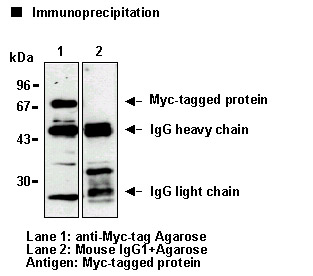Anti-Myc-tag mAb-Agarose
| Code | Size | Price |
|---|
| MBL-M047-8 | 200 ug | £280.00 |
Quantity:
Prices exclude any Taxes / VAT
Overview
Host Type: Mouse
Antibody Isotype: IgG1
Antibody Clonality: Monoclonal
Antibody Clone: PL14
Regulatory Status: RUO
Application: Immunoprecipitation (IP)
Shipping:
4°C
Storage:
4°C
Images
Documents
Further Information
Applications:
IP - 20 uL of gel slurry
Background:
Epitope tagging has widely been accepted technique that fuse an epitope peptide to a certain protein as a marker for gene expression. With this technique, the gene expression can be easily monitored on western blotting, immunoprecipitation and immunofluorescence utilizing with an antibody that recognizes such an epitope. Amino acid sequences that are widely used for the epitope tagging are as follow; YPYDVPDYA (HA-tag), EQKLISEEDL (Myc-tag) and YTDIEMNRLGK (VSV-G-tag), which corresponding to the partial peptide of Influenza hemagglutinin protein, human c-myc gene product and Vesicular stomatitis virus glycoprotein respectively.
Conjugate:
Agarose
Formulation:
200 ug of anti-Myc-tag monoclonalantibody covalently coupled to 200 ul of agarose gel andprovided as a 50% gel slurry suspended in PBS containingpreservative (0.09% sodium azide) for a total volume of400 ul.
Immunogen Translated:
6myc-tag fusion protein
Reactivity:
This antibody recognizes Myc-Tag peptide sequence on Immunoprecipitation.
Shelf Life:
1 year
Source:
This antibody was purified from hybridoma
(clone PL14) supernatant using protein A agarose. This
hybridoma was established by fusion of mouse myeloma
cell P3U1 with Balb/c mouse splenocyte immunized with
6myc-tag fusion protein.
Target:
Myc
References
Hirota, K., et al. J. Biol. Chem. 278, 13056-13060 (2003)
Tojo, M., et al. J. Biol. Chem. 277, 46576-46585 (2002)
Sasaki, A., et al. J. Biol. Chem. 277, 22541-22546 (2002)
Ohya, T., et al. J. Biol. Chem. 277, 28099-28108 (2002)
Fukumoto, T., et al. J. Biol. Chem. 276, 38441-38448 (2001)
Yoshioka, K., et al. Proc. Natl. Acad. Sci. USA, 98, 7617-7622 (2001)
Mukai, J., et al. J. Biol. Chem. 275, 17566-17570 (2000)




